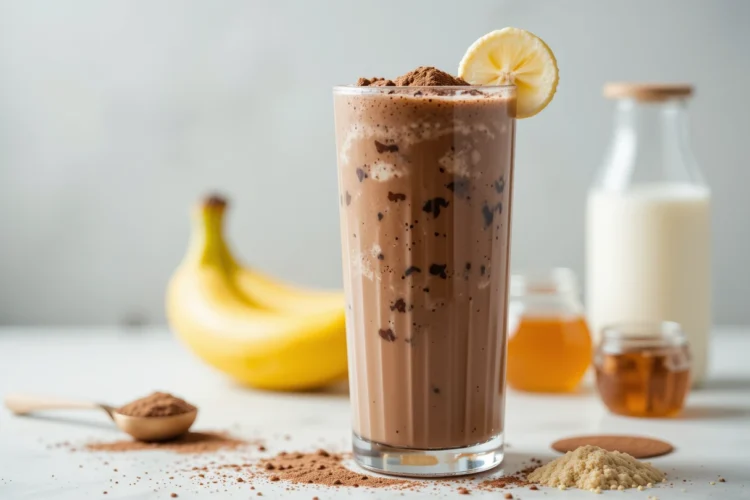Chocolate shakes bring back memories of childhood treats, but they don’t have to derail your health goals. When made with the right ingredients, chocolate shakes can actually support your weight management journey while satisfying those sweet cravings that often lead to less healthy choices.
The key is transforming the classic milkshake concept by using nutrient-dense ingredients that provide sustained energy, essential nutrients, and appetite satisfaction. Instead of empty calories from sugar and artificial ingredients, these recipes focus on whole foods that work with your body’s natural processes.
This article will share the best chocolate protein shake recipes for weight loss, featuring simple combinations of milk, banana, cocoa powder, protein powder, and optional healthy add-ins. These recipes are designed to be both satisfying and supportive of your wellness goals, proving that healthy eating doesn’t require giving up the flavors you love.
What are Chocolate Protein Shakes?
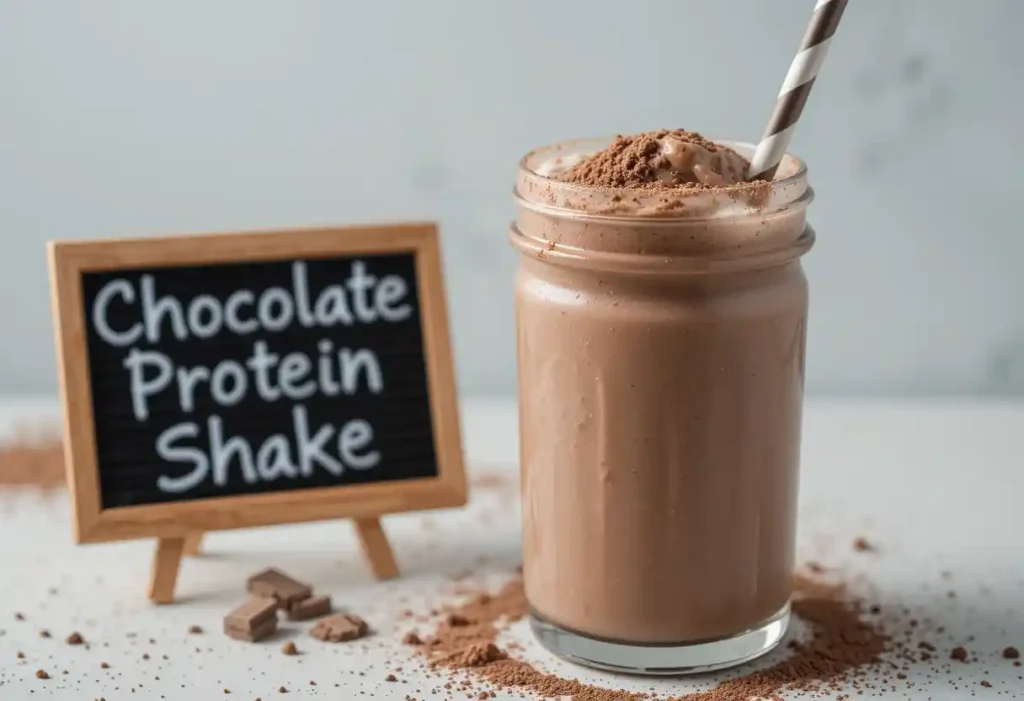
Chocolate protein shakes are nutrient-dense beverages that combine high-quality protein powder with natural cocoa, milk or milk alternatives, fruits, and other wholesome ingredients. Unlike traditional milkshakes that rely heavily on ice cream and sugar for flavor, these shakes get their sweetness from natural sources like bananas and their richness from protein and healthy fats.
The fundamental difference between regular milkshakes and protein shakes lies in their nutritional profile and purpose. While traditional shakes are treats high in sugar and calories with little nutritional value, protein shakes are designed to provide sustained energy, support muscle health, and contribute to overall nutrition goals.
These shakes typically contain 20-30 grams of protein per serving, along with fiber, vitamins, and minerals from whole food ingredients. The chocolate flavor comes from unsweetened cocoa powder, which provides antioxidants without added sugars, making it a healthier way to enjoy chocolate flavors.
What makes protein shakes particularly valuable is their versatility – they can serve as post-workout recovery drinks, meal replacements when balanced properly, or satisfying snacks that help manage hunger between meals.
Why Choose Chocolate Protein Shakes for Weight Loss?
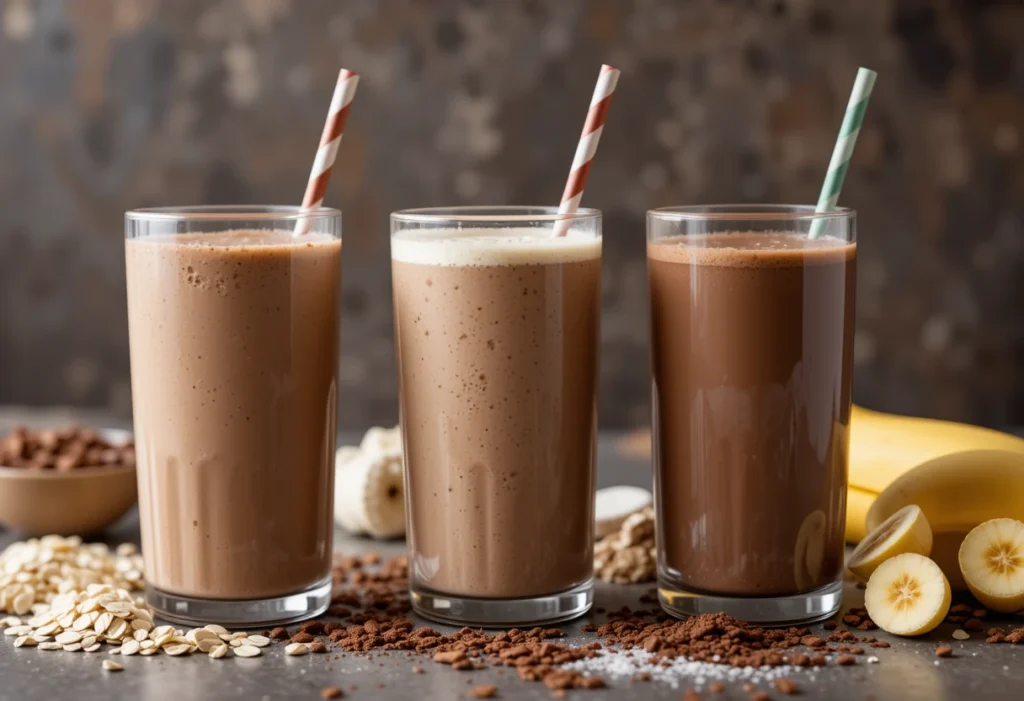
Protein plays a crucial role in weight management through several biological mechanisms. When you consume adequate protein, it increases satiety hormones that help you feel full longer, naturally reducing overall calorie intake throughout the day. Protein also has a higher thermic effect than carbohydrates or fats, meaning your body burns more calories digesting and processing it.
Additionally, protein helps preserve lean muscle mass during weight loss, which is essential for maintaining a healthy metabolism. When you lose weight without adequate protein intake, you risk losing muscle tissue along with fat, which can slow your metabolic rate and make long-term weight maintenance more challenging.
The chocolate flavor aspect is psychologically important for adherence to healthier eating patterns. When people feel deprived of enjoyable flavors, they’re more likely to abandon their nutrition goals entirely. Chocolate protein shakes provide a satisfying treat that doesn’t conflict with health objectives.
Homemade protein shakes offer significant advantages over pre-packaged alternatives. You control the ingredient quality, sugar content, and portion sizes while avoiding artificial preservatives and excessive processing. This control allows you to customize the nutritional profile to match your specific needs and preferences.
Essential Ingredients for Chocolate Protein Shake Recipes
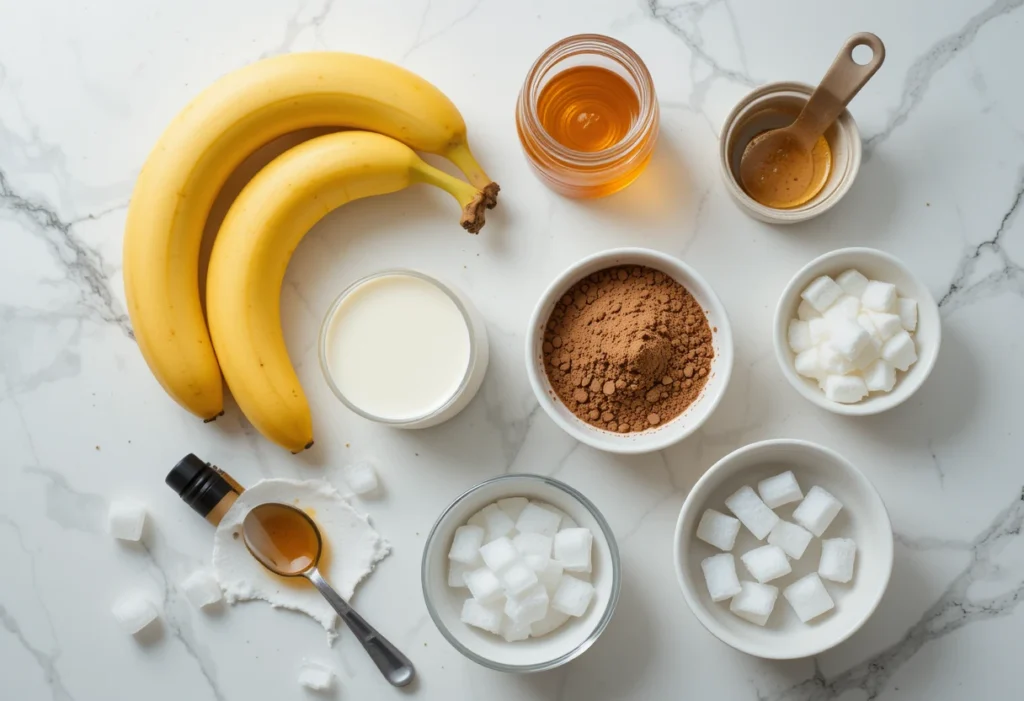
Base Ingredients:
• 1 cup milk or milk alternative – Provides liquid base and additional protein if using dairy milk
• 1 medium banana – Adds natural sweetness, potassium, and creamy texture
• 1 scoop protein powder – The primary protein source (20-25 grams typically)
• 1 tablespoon honey or natural sweetener – Balances any bitter notes from cocoa
• 2 tablespoons unsweetened cocoa powder – Provides chocolate flavor and antioxidants
• 1/2 teaspoon vanilla extract – Enhances overall flavor profile
• 1/2 cup ice – Creates desired consistency and temperature
Optional Nutritional Boosters:
• 1 tablespoon natural peanut butter – Adds healthy fats and additional protein
• 2 tablespoons rolled oats – Increases fiber and provides sustained energy
• 1 tablespoon chia seeds – Omega-3 fatty acids and fiber
• 1 tablespoon almond butter – Alternative to peanut butter with different mineral profile
• 1/4 cup Greek yogurt – Extra protein and probiotics
Choosing the Right Protein Powder: Select unflavored or vanilla protein powder to avoid conflicting with the chocolate flavor. Whey protein offers complete amino acids and quick absorption, making it ideal for post-workout recovery. Plant-based options like pea, hemp, or brown rice protein work well for those avoiding dairy or following vegetarian diets.
Step-by-Step Instructions for Making Chocolate Protein Shakes
Making a chocolate protein shake at home is simple, quick, and much healthier than buying pre-made options. Here’s a clear guide you can follow:
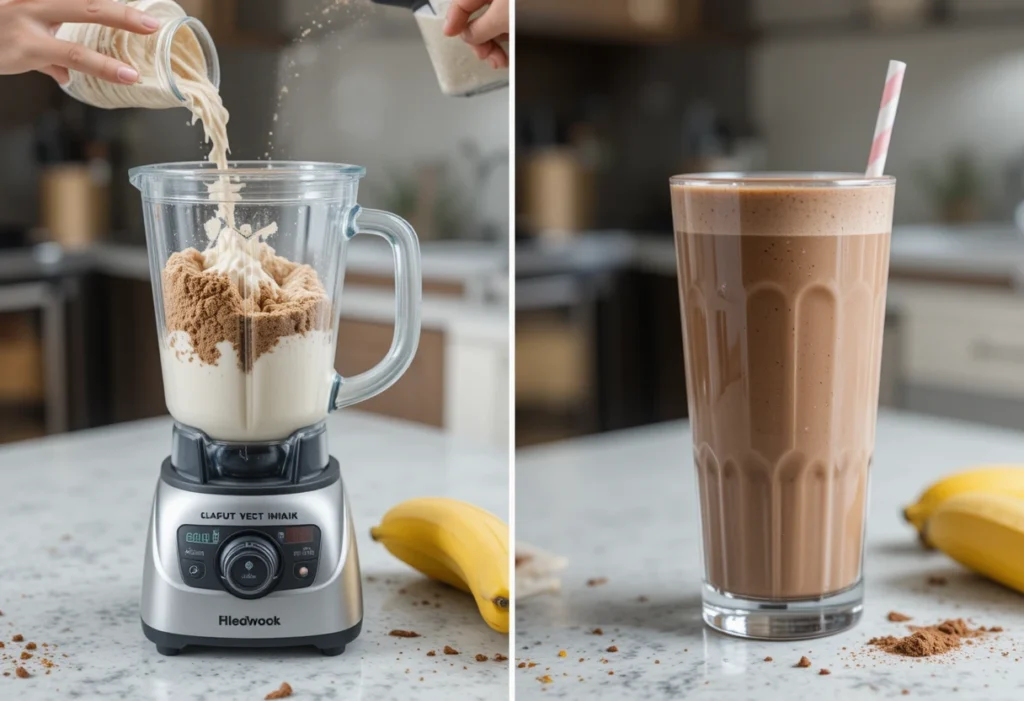
Step 1: Gather All Ingredients
Start by collecting everything you need:
- 1 cup milk (any kind – dairy, almond, soy, or oat milk).
- 1 banana (adds natural sweetness and creaminess).
- 1 scoop protein powder (plain, whey, or plant-based).
- 2 tablespoons unsweetened cocoa powder.
- 3 tablespoons honey (or adjust to taste).
- 1/2 cup ice cubes (for a chilled, refreshing texture).
- 1/4 teaspoon vanilla extract.
Optional add-ins: a spoon of peanut butter, chia seeds, or oats for extra nutrition.
Step 2: Add Milk and Ice Cubes to the Blender
Pour the milk into your blender first. This makes blending smoother and avoids powder sticking to the bottom. Add the ice cubes next to make the shake cold and frothy.
Step 3: Add the Rest of the Ingredients
Now put in the banana, cocoa powder, protein powder, and honey. These are the main flavor and nutrition boosters. If you want it extra chocolaty, you can add a little more cocoa powder.
Step 4: Blend Until Smooth and Creamy
Blend everything on high speed for about 30–45 seconds. The shake should look creamy, thick, and smooth. If you notice chunks of banana or powder, blend for a little longer.
Step 5: Adjust the Taste
Give your shake a quick taste. If you like it sweeter, add a touch more honey or a natural sweetener like stevia. If you want more flavor depth, add a few drops of vanilla extract.
Step 6: Serve and Enjoy
Pour the shake into a tall glass or shaker bottle. Drink it right away for the freshest taste. It’s best enjoyed chilled, especially after a workout or as a quick breakfast.
Variations of Chocolate Protein Shake Recipes for Weight Loss
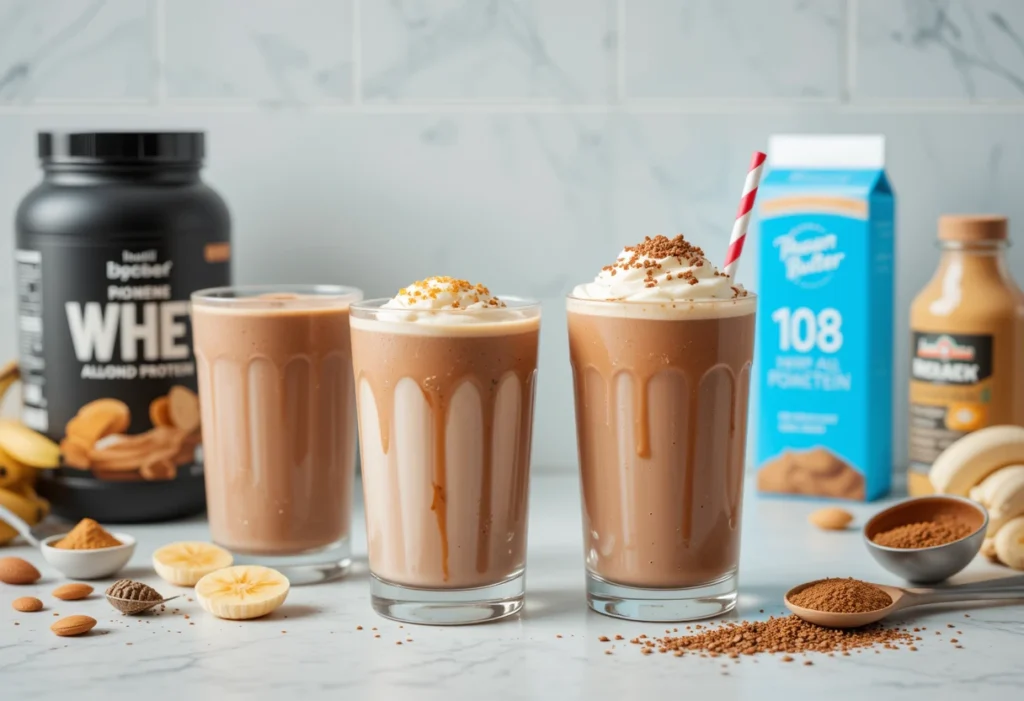
Chocolate Protein Powder Shake Recipes for Weight Loss
For a lower-calorie version, replace regular milk with unsweetened almond milk and use stevia instead of honey. Add 1 tablespoon of ground flaxseed for omega-3 fatty acids and extra fiber. This variation contains approximately 220-250 calories while maintaining 22-25 grams of protein.
Consider using frozen cauliflower florets (1/4 cup) as a secret ingredient that adds creaminess and nutrients without affecting taste. This technique increases the nutritional density while keeping calories controlled.
Chocolate Whey Protein Shake Recipes for Weight Loss
Whey protein powder offers superior amino acid profiles and faster absorption rates, making it particularly beneficial for people who exercise regularly. This version works best consumed within 30 minutes after strength training when muscles are most receptive to protein synthesis.
Use 1 scoop chocolate or vanilla whey protein, reduce cocoa powder to 1 tablespoon, and add 1/2 cup cold brew coffee for an energizing pre-workout or morning shake. The caffeine can provide an additional metabolic boost while the protein supports muscle recovery.
Athletes and regular gym users benefit most from whey protein due to its complete amino acid profile and rapid absorption rate, which supports optimal muscle protein synthesis.
Best Chocolate Protein Shake Recipes for Weight Loss
Top Combination Rankings:
- Classic Balance: Almond milk base with banana and vanilla protein (280 calories, 25g protein)
- Whey Power: Whey protein with Greek yogurt addition (320 calories, 32g protein)
- Nutty Satisfaction: Added almond butter for healthy fats (380 calories, 28g protein)
The best times to consume these shakes are morning (as part of breakfast), post-workout (within 2 hours), or as an afternoon snack when energy levels typically dip.
Chocolate Peanut Butter Protein Shake Recipes for Weight Loss
Natural peanut butter adds monounsaturated fats that support satiety and nutrient absorption. However, portion control is crucial since 2 tablespoons contain about 190 calories. Start with 1 tablespoon and increase only if you can afford the additional calories within your daily goals.
The combination of protein and healthy fats in this variation provides exceptional appetite control, often keeping people satisfied for 3-4 hours. This makes it particularly useful as a meal replacement when balanced with additional nutrients.
To manage calories while enjoying this flavor combination, use powdered peanut butter (like PB2) which provides peanut flavor with significantly fewer calories than regular peanut butter.
Tips to Make Your Chocolate Protein Shake Healthier
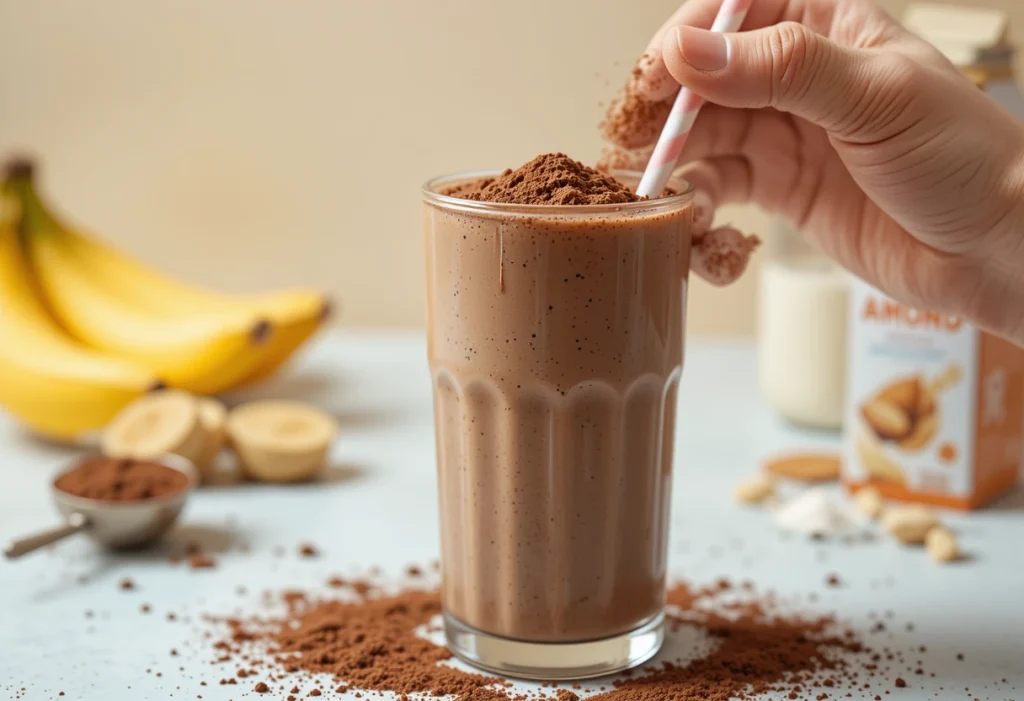
Smart Ingredient Swaps:
- Use unsweetened almond, oat, or cashew milk instead of whole dairy milk to reduce calories
- Replace honey with stevia, monk fruit, or dates for lower glycemic impact
- Add spinach or kale for extra nutrients without affecting chocolate flavor
- Include 1 tablespoon of chia seeds or ground flaxseed for omega-3 fatty acids
Nutritional Boosters: Fresh or frozen berries add antioxidants and natural sweetness. Zucchini (1/4 cup frozen) increases vegetable intake invisibly. Collagen powder provides additional protein and may support skin and joint health.
Portion Control Guidelines: Measure liquid ingredients carefully, as they significantly impact final calorie content. Keep add-ins like nut butters to 1 tablespoon servings. If the shake replaces a meal, ensure it contains 400-500 calories with balanced macronutrients.
Common Mistakes to Avoid
Many people unknowingly sabotage their weight management goals by adding excessive sweeteners. Start with minimal honey or dates and let the banana provide most of the sweetness. Your taste preferences will adjust over time to appreciate less sweet flavors.
Overusing nut butters is another frequent error. While healthy fats are important, 2 tablespoons of almond butter contains nearly 200 calories. Measure portions carefully and consider powdered alternatives when you want the flavor without all the calories.
Failing to measure protein powder properly can result in either inadequate protein intake or excessive calories. Use the scoop provided with your protein powder and level it off for consistent results.
Treating protein shakes as complete meal replacements without considering overall nutritional balance can lead to nutrient deficiencies. While shakes can replace meals occasionally, they work best as part of a varied diet that includes whole foods.
FAQs
Can I drink chocolate protein shakes every day?
Daily consumption is generally safe for healthy individuals, but variety in your diet remains important. Rotate between different protein sources and don’t let shakes replace more than one meal per day regularly.
Are these shakes suitable for both men and women?
Yes, though men typically need larger portions due to higher calorie and protein requirements. Women might use 3/4 scoop of protein powder while men might use 1-1.5 scoops based on their individual needs.
What’s the difference between whey protein and plant-based protein?
Whey protein is derived from dairy and contains all essential amino acids with high bioavailability. Plant-based proteins may require combining different sources to achieve complete amino acid profiles, but they work well for those avoiding dairy or following vegetarian diets.
Can chocolate shakes really help with weight loss?
When used as part of a balanced nutrition plan with appropriate calorie control, protein shakes can support weight loss by increasing satiety, preserving muscle mass, and providing satisfying alternatives to higher-calorie treats.
Conclusion
Chocolate protein shakes prove that supporting your health goals doesn’t require sacrificing flavors you enjoy. These recipes provide practical ways to increase protein intake, manage hunger, and satisfy chocolate cravings while working toward your wellness objectives.
The key to success lies in viewing these shakes as tools within a broader approach to balanced nutrition rather than magic solutions. When combined with regular physical activity, adequate sleep, and a varied diet rich in whole foods, protein shakes become valuable allies in your journey toward better health.
Experiment with different variations to find combinations that match your taste preferences and nutritional needs. Remember that sustainable changes happen gradually, and finding satisfying alternatives to less nutritious options is an important part of building lasting healthy habits.
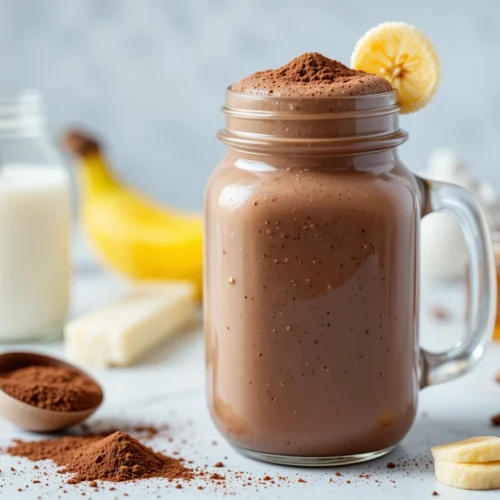
Chocolate Protein Shake Recipe for Weight Loss
Ingredients
- 1 cup milk dairy or unsweetened almond/soy/oat milk
- 1/2 cup ice cubes
- 1 medium banana
- 1 scoop plain unflavored protein powder
- 2 tablespoons unsweetened cocoa powder
- 3 tablespoons honey or adjust to taste
- 1/4 teaspoon vanilla extract
Instructions
- Gather all ingredients.
- Add milk and ice cubes into a blender.
- Add banana, cocoa powder, protein powder, and honey.
- Blend on high speed until smooth and creamy (30–45 seconds).
- Taste and adjust sweetness with honey or natural sweetener. Add vanilla extract for extra flavor.
- Pour into a glass and serve chilled.
